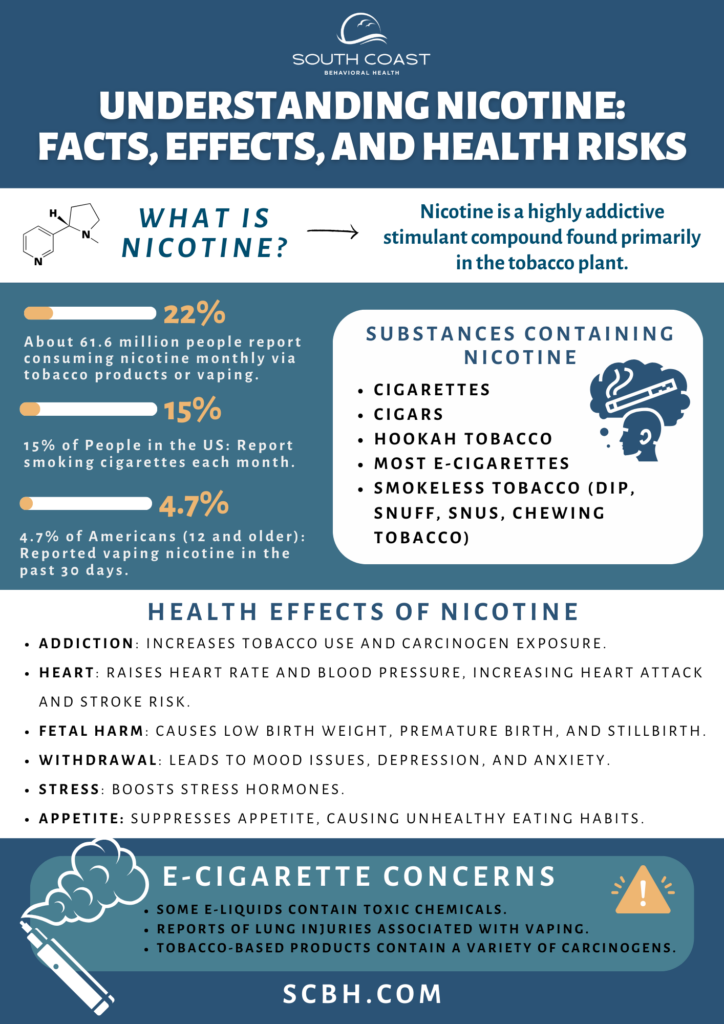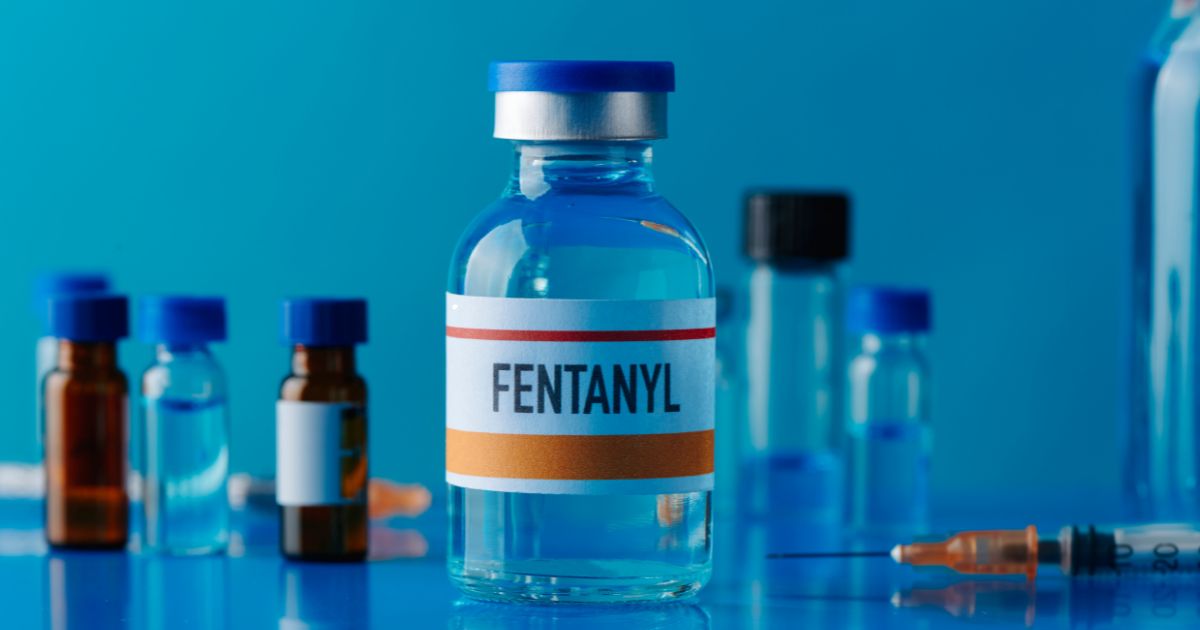What Is Nicotine?
Nicotine is a highly addictive stimulant compound found primarily in the tobacco plant (Nicotiana tabacum). It can also be found in smaller amounts in nightshades. People typically use it for the pleasurable and calming feelings it produces in the brain. Over time, however, the brain starts to crave these feelings, leading to regular use and, for many, addiction.
People mainly consume nicotine in various tobacco-based products, but vaping has become increasingly popular.
Here are some quick nicotine facts:
- Twenty-two percent of the US population (about 61.6 million people) report consuming nicotine in some form (whether via tobacco products or vaping) on a monthly basis.
- More than 15% of people in the US report smoking cigarettes each month.
- Among Americans 12 and older, 4.7% reported vaping nicotine in the past 30 days.
In this article, we’ll cover how long nicotine stays in your system, along with other questions you might have.
What Substances Contain Nicotine?
All tobacco products contain nicotine, including cigarettes, cigars, smokeless tobacco (such as dip, snuff, snus, and chewing tobacco), hookah tobacco, and most e-cigarettes.
How Much Nicotine Is in a Vape?
Standard vape levels are available in a variety of doses. Commercial vape juice is available in nicotine concentrations of 0 mg, 3 mg, 6 mg, 12 mg, and 18 mg per milliliter. For consumers with a higher tolerance level, high nicotine dose cartridges with 24-36 milligrams per milliliter are also available.
How Much Nicotine Is in a Cigarette?
Each cigarette contains an average of about 10-15 mg of nicotine, but smokers absorb only about 1-2 mg of nicotine per cigarette.
Get confidential help from our addiction treatment specialists in Orange County. Call to join our rehab program today!
Call 866-881-1184Is Nicotine Bad for You?
While it’s not the primary cause of diseases associated with smoking (such as lung cancer, emphysema, or cardiovascular disease), nicotine does have various health effects on its own:
- Nicotine is highly addictive. This addiction can lead to increased consumption of tobacco products, which exposes users to harmful carcinogens and other toxic compounds.
- Nicotine increases heart rate and blood pressure. Chronic exposure can contribute to the hardening of arterial walls, potentially increasing the risk of heart attack and stroke.
- There’s evidence that nicotine can harm fetal development, leading to low birth weight, premature birth, and stillbirth. Pregnant individuals are strongly advised to avoid nicotine.
- Nicotine withdrawal can cause mood disturbances, depression, and anxiety.
- Nicotine can increase the release of stress hormones.
- Some people use nicotine for its appetite-suppressing effects. This can lead to an unhealthy relationship with food.
In addition, it should be noted that, while often marketed as a safer alternative to smoking, e-cigarettes introduce their own set of concerns. For instance, some e-liquids have been found to contain toxic chemicals, and there have been reports of lung injuries associated with vaping.
And, of course, any tobacco-based product will contain a variety of carcinogens, especially cigarettes. Cigars and pipes also contain carcinogens, albeit to a somewhat lesser extent than cigarettes, which contain many additives.
How Long Does Nicotine Stay in Your System?
The length of time nicotine and its metabolites stay in your system can depend on numerous factors, including the frequency of use, the amount used, individual metabolism, and the test used to detect it.
- Blood — Nicotine can usually be detected in the blood for 1-3 days after consuming tobacco or nicotine products. Cotinine can be detected in the blood for up to 10 days.
- Urine — Nicotine itself may be detected in urine for up to 3 days, while cotinine can be detected for up to 3 weeks or longer, depending on factors like the individual’s metabolism, hydration level, and tobacco usage.
- Saliva — Nicotine may be detectable in saliva for up to 4 days.
- Hair — Hair testing can detect nicotine for up to 1-3 months after exposure. In some cases and especially with chronic exposure, it might be detectable for up to a year.
- Breath — Breath tests can detect nicotine for up to 24 hours after ingestion.
Remember, these are general estimates, and the actual detection time can vary based on multiple factors. Additionally, individuals who use tobacco or nicotine products regularly will likely have detectable levels for longer periods compared to occasional users.
If you’re trying to quit smoking or using nicotine products, consider reaching out to medical professionals or support groups for guidance and resources.

Looking for quality substance abuse treatment that’s also affordable? South Coast accepts most major insurance providers. Get a free insurance benefits check now.
Check Your CoverageAddiction Treatment at South Coast Behavioral Health
For those struggling with nicotine addiction, South Coast Behavioral Health offers compassionate and affordable addiction treatment.
The first step is going through a medical detox. Our medical detox program in California is staffed by caring and compassionate professionals who can provide you with medications to manage your withdrawal symptoms.
At South Coast, we take pride in offering care that is closely tailored to specific issues. To that end, we offer gender-specific detox programs, with medical detox for men in Irvine, CA, and medical detox for women in Huntington Beach, CA.
After detoxing, proper treatment can begin.
Treatment for substance abuse takes place along an entire spectrum of care. Along that entire spectrum are various behavioral therapies, support groups, and the use of medically-assisted treatment (MAT).
These levels of treatment are, in order, as follows:
Residential Treatment in California
After successfully completing medical detox, you’ll move to inpatient treatment in Orange County, California. There, you’ll receive medically-assisted treatment and dual diagnosis treatment to deal with any cravings or co-occurring mental health issues you may be battling. We also offer residential treatment facilities in Costa Mesa, Irvine, and Huntington Beach for those who desire gender-specific treatment. There, patients get round-the-clock medical attention and monitoring while living at our facility full-time.
In addition to individual and group counseling and medication management, you’ll also have access to leisure activities and family support services.
Partial Hospitalization in California
Most clients start substance abuse treatment with South Coast in our residential treatment program. After completing that, many desire something that still provides structure and support but with extra space and time to oneself. For that, we offer Partial Hospitalization in Newport Beach.
A step down from inpatient care but with more structure than conventional outpatient programs, partial hospitalization offers a good balance for those looking to ease back into normal life. Clients can receive care five to seven days a week for a number of hours each day, returning back to their sober living homes in the evening.
This way, they can recover without putting their daily lives completely on hold, receiving intense therapeutic interventions like group and individual therapy, skills development, and medication management as necessary.
Intensive Outpatient Treatment in California
For those leaving inpatient residential treatment or partial hospitalization, intensive outpatient programs (IOP) are yet another gradual step forward on the road to recovery.
With a focus on group therapy, individual counseling, and education, clients undergoing Intensive Outpatient Treatment in Newport Beach can meet three to five days a week. Each session lasts three hours.
This level of care requires the least amount of attendance at a facility.
Get Started Today
If you or a loved one are struggling with nicotine addiction but wonder how long addiction counseling takes or have other questions, call us at 866-881-1184 or contact us here. Our highly qualified staff will be happy to help give you an idea of what to expect from your addiction recovery timeline, help verify your insurance, and assist with any other questions you may have.
- Side effects of pseudoephedrine – NHS (www.nhs.uk)
- Pseudoephedrine (Oral Route) Side Effects – Mayo Clinic
- Self-administration of (+)-methamphetamine and (+)-pseudoephedrine, alone and combined, by rhesus monkeys – PMC (nih.gov)
- The Controlled Substances Act (dea.gov)
- CMEA (The Combat Methamphetamine Epidemic Act of 2005) (usdoj.gov)
- The Top 7 Pseudoephedrine (Sudafed) Interactions to Know About – GoodRx
Synthetic opioids such as fentanyl and oxycodone have become major drugs of abuse over the last decade. One of the newest drugs to emerge is isotonitazene, which can be deadly for first-time users. It’s part of a growing trend of novel synthetic opioids appearing on the black market and poses a significant challenge for public health and law enforcement agencies.
Read more to learn why some are calling this synthetic pain medication the “new fentanyl.”
What Is Isotonitazene?
Since the late 80’s, the United States has faced a growing opioid crisis, characterized by fatal overdoses in the tens of thousands each year. For most of the last decade, synthetic opioids like fentanyl and oxycodone have been the most dangerous drugs of the crisis.
Since the Chinese ban on fentanyl production in 2019 and increasing US regulation on Oxycodone production, several new opioids have entered the illicit drug market. One of the newer synthetic opioids to emerge is isotonitazene.
First synthesized in the 1950s, isotonitazene comes in both tablet and powder form. Originally, the drug was part of the pharmaceutical industry’s attempt to develop safer opioid medications. Isotonitazene, commonly referred to on the street as “ISO,” belongs to a chemical class of nitro benzimidazoles. In medical settings, this class of compounds is often used for its antimicrobial properties.
More importantly, isotonitazene is the first opioid of this class to be discovered on the black market in recent years. Unfortunately, the differences in the drug’s chemical structure complicates efforts to treat overdoses from fentanyl or other opioids contaminated with ISO.
How Potent is Isotonitazene?
ISO is significantly more potent than more traditional opioids like morphine, and has been associated with the risk of fatal overdose, similar to other opioids. A study in mice found ISO to be significantly more potent than morphine. And according to in vitro pharmacological evidence, it’s 20 times as potent as fentanyl.
Due to its potency, difficulty of detection, and increasing availability, some have labeled isotonitazenethe “new fentanyl.”
Since its appearance in the US in 2019, at least several hundred deaths have been attributed to Isotonatizene. In an effort to deal with this new threat, it has temporarily been made a Schedule I drug by the US Attorney General. This designation will last for two years while new legislation to address it is pending.
Perhaps the worst part: studies show that patients who overdosed on fentanyl mixed with ISO, compared to just fentanyl alone, required more naloxone (Narcan) to be resuscitated. This makes synthetic opioids mixed with ISO more resistant to the actions of first responders.
Law enforcement data indicates that isotonitazene is increasingly prevalent in the United States illicit drug market. In April 2019, the United States Customs and Border Protection seized 1.6 grams of isotonitazene in California.
Since then, it has shown up across California, in places such as San Francisco and Santa Rosa. Worldwide, it has continued to increase in prevalence, according to 2024 data from the United Nations Office on Drugs and Crime.
Isotonitazene has been called the new fentanyl due to how potent it is. Some reports have called it 20 to 100 times more potent than fentanyl. While direct comparisons are difficult, it’s safe to say it’s much more potent than both morphine and oxycodone.
Like other opioids, isotonitazene can cause respiratory depression, where breathing becomes shallow or stops altogether. This is the primary cause of fatal opioid overdoses. The risk is higher with more potent synthetic opioids like isotonitazene.
This high potency, combined with the fact it’s often marketed by dealers as being some other, less potent opioid, means an unsuspecting user runs a high risk of overdose.
What Does the Science Say?
According to a study taken in Milwaukee and Chicago, over a one-and-a-half-year period there were 40 ISO-related deaths – 4% of the total deaths from synthetic opioids as a whole. Since then, ISO has been causing between 40 to 50 deaths a month, with several hundred deaths per year.
While that figure may not seem like a lot, compared to the thousands that die of fentanyl or other opioids, it’s important to keep in mind that Isotonitazene is very new on the scene. As a result, only a few jurisdictions routinely test for it in overdose cases. Therefore, while we can’t know the full extent of ISO’s danger, it’s certainly not “safe” by any means.
It’s also worth noting: when fentanyl first emerged in the early-2010’s, its death count was also in the low hundreds. Then, starting in 2016, it began spiking, and is now at almost 2,000 deaths per year.
Both drugs can also be cut with other, relatively less potent opioids for a cheaper but stronger high. And both can themselves become more potent over time. Thus, the danger of synthetic opioids like ISO should not be underestimated.
And ISO isn’t just being found in just opioids, either – USA Today reported in 2020 that people dying of cocaine overdoses in Illinois and Indiana were found to also have ISO in their system. This is a versatile drug that can show up in any number of substances, including prescription medication.
Finally, ISO is likely not the last synthetic opioid we’ll see. Drug dealers are constantly refining their techniques, coming up with new drugs by slightly tweaking the chemical structure of old ones to avoid detection. Unfortunately, authorities have little way of predicting what will be the next “new fentanyl,” meaning they will continue having to play catch-up with criminals.










